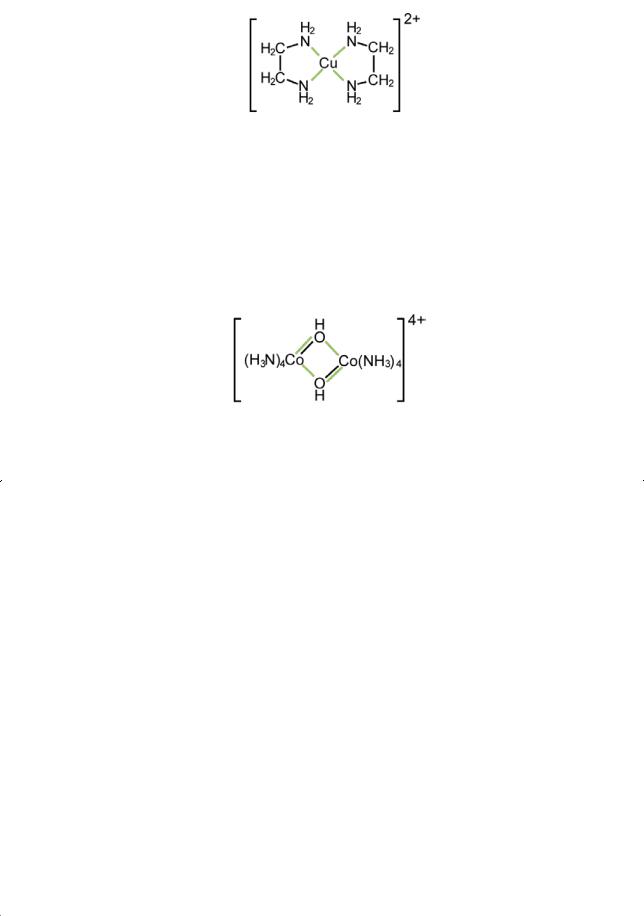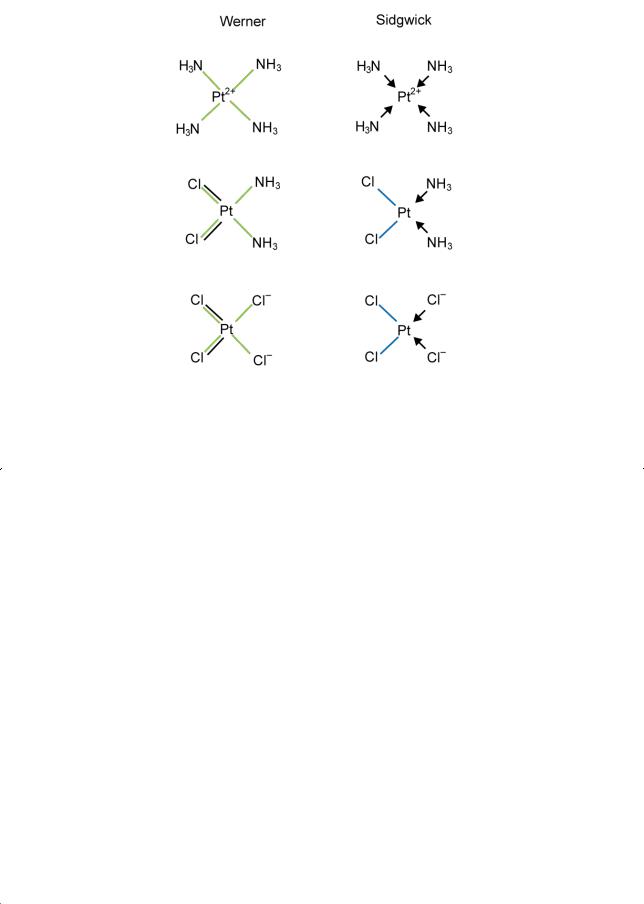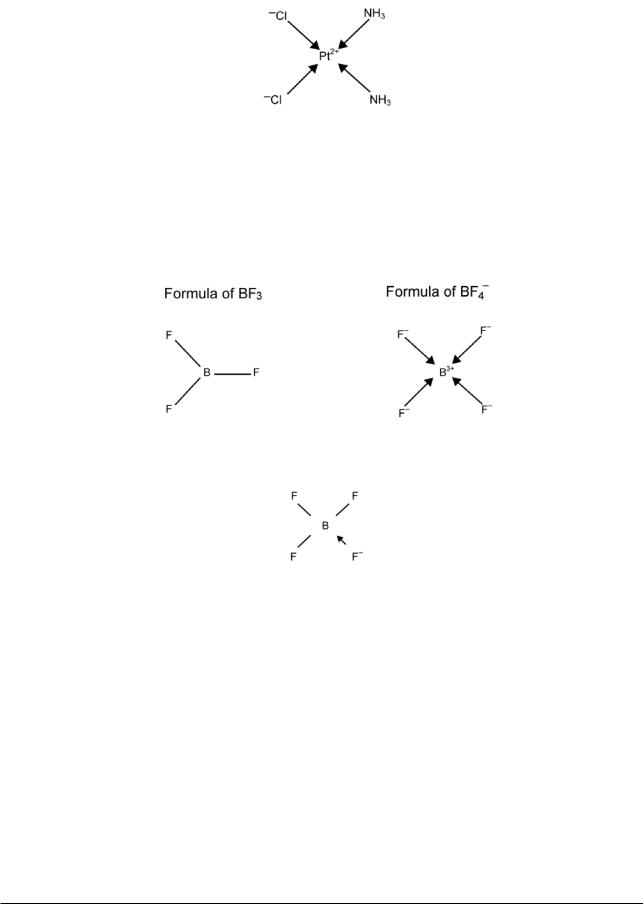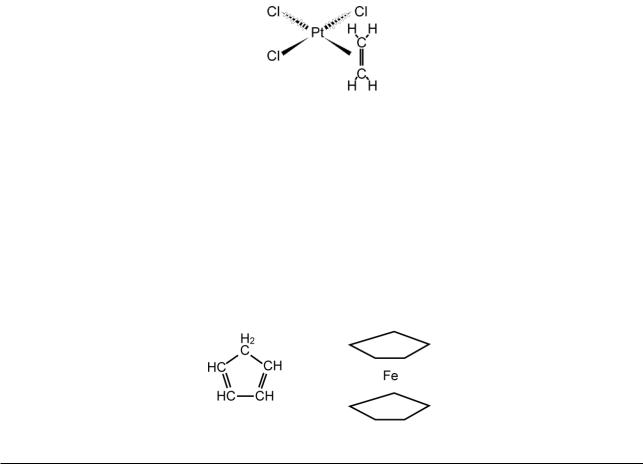
introduction-to-inorganic-chemistry
.pdf
Introduction to Inorganic Chemistry |
Coordination compounds |
|
|
A multidentate ligand is said to function as a “chelate” ligand when it attaches itself to a central atom through more than one of its coordinating atoms, as in the example above. The resulting species is called a chelate. This comes from the Greek word for a crab’s claw (khēlē) and describes the way in which the ligand grasps the central atom between two or more of its coordinating members.
A ligand is said to function as a “bridging” ligand when it is attached to more than one coordinating centre. An example is the hydroxide ion in
Coordination entities of this sort are described as “polynuclear”, the number of central atoms being designated by the terms “mononuclear”, “dinuclear”, etc.
Please click the advert
Download free ebooks at bookboon.com
111

Introduction to Inorganic Chemistry |
Coordination compounds |
|
|
Note
As “nuclear” is a Latin word, it should properly have Latin numerical prefixes. However, the use of Greek prefixes is well established in this context (contrast “multinuclear” NMR). IUPAC also use Greek prefixes with “dentate” (“didentate”, etc.).
13.3 Nomenclature of coordination compounds
Coordination compounds are named according to the recommendations of IUPAC (see Chap. 7). The basic rules are as follows.
1.A coordination entity has a one-word name, formed from the name of the central atom and the names of the ligands.
2.If the entity is a cation or neutral, the usual name of the central atom is used (e.g. cobalt). If the entity is an anion, the name of the central atom is changed to end in -ate (e.g. cobaltate). For a few elements, Latin forms are used for anions (e.g. ferrate, cuprate).
3.Most neutral ligands have their usual names. A few have special names, e.g.
NH3 |
ammine |
H2O |
aqua |
4. Anionic ligands have their usual names, modified to end in –o, e.g.
CH3CO2− |
acetato |
|
A few have special names, e.g. |
|
|
Cl− |
|
chloro |
O2− |
|
oxo |
OH− |
|
hydroxo |
NO2− (coordinated through N) |
nitro |
|
5.The numbers of ligands are indicated by Greek numerical prefixes (di, tri, tetra, penta, hexa, etc.). Where these would create ambiguity, multiplicative prefixes (bis, tris, tetrakis, pentakis, hexakis, etc.) and brackets are used, e.g. bis(methylamine).
6.Ligands are listed first, in alphabetical order (e.g. triamminedibromochloro), followed by the central atom.
7.There are alternative ways of indicating the overall stoicheiometry, as illustrated below for the compound [CoCl(NH3)5]Cl2 (cf. Chap. 7).
Download free ebooks at bookboon.com
112

Introduction to Inorganic Chemistry |
Coordination compounds |
|
|
(i)By specifying the oxidation number of the central atom, e.g. pentaamminechlorocobalt(III) chloride
(ii)By specifying the charge on the coordination entity, e.g. pentaamminechlorocobalt(2+) chloride
(iii)By specifying the proportions of the constituent ions, e.g. pentaamminechlorocobalt dichloride
8.Bridging ligands are indicated by µ and separated by hyphens, e.g. -µ-chloro-, -di-µ-hydroxo-
Exercise
Name the coordination compounds in the previous exercise.
(Click here for answers http://bit.ly/eaQNz5 or see Appendix 1)
13.4 Bonding in coordination compounds
The bonding in coordination compounds is most easily described in the manner first proposed by the Oxford chemist N. V. Sidgwick in 1923. Sidgwick suggested that
(i)the bonds indicated by both a black and a green line ( ) in the above formulae are ordinary covalent bonds,
) in the above formulae are ordinary covalent bonds,
(ii)the bonds indicated by a green line alone (——) are donor bonds, the ligand acting as the donor and the central atom as the acceptor.
This is illustrated below, where I have taken the single black lines in Werner's formulae to be ionic bonds and used my symbol for a covalent bond (Section 8.3):
Download free ebooks at bookboon.com
113

Introduction to Inorganic Chemistry |
Coordination compounds |
|
|
Please click the advert
Download free ebooks at bookboon.com
114

Introduction to Inorganic Chemistry |
Coordination compounds |
|
|
Sidgwick based his hypothesis on the following observations:
(i)All ligands thought to be bound by a dative bond possess at least one unshared pair of electrons, and no ligand is ever required to form more dative bonds than the number of lone pairs it has available.
(ii)For many of the more stable coordination compounds (stable, that is, with respect to dissociation), the number of electrons calculated to be round the central atom on the above model is the same as the number of electrons round the atom of the next inert gas. For example:
[Co(NH3)6]3+ |
Co3+ has |
24 electrons |
|
6NH3 donate |
12 electrons |
|
Total |
36 cf. Kr |
This he called the “effective atomic number rule”. It is now called the “inert/noble gas rule”, or the “18-electron rule”. The latter is based on the number of outer electrons (i.e. electrons outside an [Ar], [Kr], or [Xe4f14] core):
[Co(NH3)6]3+ |
Co3+ has |
6 outer electrons |
|
6NH3 add |
12 electrons |
|
Total |
18 |
Sidgwick recognized that, when the above formula for [PtCl4]2– is drawn as a Lewis structure with only dots, all the Pt–Cl bonds are the same (Pt:Cl), as observed experimentally. He accordingly also wrote the formula (in my symbolism):
This effectively places the negative charge on the platinum atom.
Sidgwick’s understanding of the bonding in coordination compounds is accepted today in a slightly modified form. This is as follows:
(i)The bonds thought by Sidgwick as covalent bonds are now regarded as having some ionic character, in common with other electron-pair bonds between unlike atoms.
(ii)These bonds are replaced by their ionic-cum-dative equivalent, i.e. A–B is replaced by A+←B–. This gives for [PtCl2(NH3)2]:
Download free ebooks at bookboon.com
115

Introduction to Inorganic Chemistry |
Coordination compounds |
|
|
This is equivalent to taking all of the black lines in the earlier formulae as ionic bonds and all of the green lines as dative bonds.
The merit of the modern formulation is that it represents all the coordinate bonds in the same way. Its disadvantage, however, is that it exaggerates the extent to which it is necessary to go beyond a simple formulation, and creates inconsistencies of the type illustrated below:
For many purposes, it is better to use Sidgwick’s formulae, with his covalent bonds reckoned as polar (—— in my symbolism):
Notes
(i)The extent to which a ligand donates its electrons varies widely. Quantum-mechanical calculations indicate that in some complex ions the degree of donation is small (e.g. in [AlF6]3− it is only ~15%). In these cases, most of the coordinate bonding comes from the attraction between the positive charge on the central atom and the negative charge on the coordinating atoms. (Neutral ligands are polar with a negative charge on the coordinating atom. For example, the charge on the N atom of NH3 is about −0.8.)
(ii)The 18-electron rule is of limited applicability among classical coordination compounds. It holds for octahedral cobalt(III) and platinum(IV) complexes, but not chromium(III) (15 electrons) or square-planar platinum(II) (16 electrons). Classical compounds of transition elements are best treated as containing variable cores (Chap. 11). Complexes containing >18 outer electrons, e.g. octahedral nickel(II) (20), can be understood in the same way as main-group compounds with >8 outer electrons: i.e. polarity of the coordinate bonds reduces the number of electrons round the central atom.
Download free ebooks at bookboon.com
116

Introduction to Inorganic Chemistry |
Coordination compounds |
|
|
(iii)Modern chemists often represent coordination entities by simple single-stroke formulae (Chap. 6), e.g.
Exercise
Write a bond formula for each of the following species:
(i) [CoCl(NH3)5]2+; (ii) [SiF6]2–; (iii) [Co(ox)3]3– (ox = oxalate, C2O42–).
(Click here for answers http://bit.ly/edB8Ce or see Appendix 1)
Please click the advert
Download free ebooks at bookboon.com
117

Introduction to Inorganic Chemistry |
Coordination compounds |
|
|
13.5 Nonclassical coordination compounds
Transition elements form coordination compounds with some ligands that bind weakly, if at all, to maingroup electron-pair acceptors (e.g. BF3). The principal ligands of this type are carbon monoxide and unsaturated hydrocarbons. Some examples of compounds are:
Nickel carbonyl, Ni(CO)4. This is made by passing carbon monoxide over nickel powder. It is a colourless liquid, boiling at 43 °C. The Ni(CO)4 molecule is tetrahedral. The C−O bond length is 1.15 Å, which is similar to that in CO (1.13 Å), and shorter than that in aldehydes and ketones (typically 1.22 Å). This suggests that the molecule should be formulated [Ni(←CO)4], with zero-valent nickel, rather than Ni(=C=O)4, with octovalent. However, the strength of the bonds compared with the weakness of bonds between CO and main-group acceptors indicates some enhancement of the bonding.
Iron pentacarbonyl, Fe(CO)5. This is made by heating iron powder with carbon monoxide in an autoclave (at 200 °C and 200 atm). It is a yellow liquid, boiling at 103 °C. The molecule is trigonal bipyramidal, with a C−O distance of 1.15 Å, as in Ni(CO)4.
Ziese’s salt. This can be made by shaking a solution of K2[PtCl4] in aqueous hydrochloric acid with ethylene. It forms yellow crystals, which X-rays show contain square-planar [PtCl3(C2H4)]− ions with the C2H4 bound sideways on:
Since C2H6 does not form a similar compound, the presumption is that the C2H4 molecule is bound to the platinum atom by one of the electron pairs from the double bond. This may be indicated: Pt←||, where || represents the double bond. There may again be some enhancement of the bonding.
Ferrocene, Fe(C5H5)2. This can be made by several methods, starting from cyclopentadiene, C5H6 (below left). It forms brown crystals, melting at 173 °C. X-rays show that, instead of each C5H5 radical being bound to the iron atom through one carbon atom (>CH Fe CH<), the rings are bound face on, producing a “sandwich” structure (below right). The rings display aromatic reactivity, undergoing substitution rather than addition.
Download free ebooks at bookboon.com
118

Introduction to Inorganic Chemistry Coordination compounds
The molecule is most easily formulated with integral bonds in the rings (as above left with −CH2− replaced by −CH<). There is then one Fe C bond to each ring and two Fe←|| bonds. However, the Fe−C and C−C bond lengths are all the same. Therefore a better formulation is with equal ring bonds, of value
1.4 (the average of three single bonds and two double). There are then five Fe--0.2--C bonds to each ring (a single bond shared between five linkages) and five Fe<--0.4--¦| bonds.
Compounds of this type conform to the 18-electron rule better than classical coordination compounds. Thus:
Ni(CO)4: a nickel atom has 10 outer electrons; each CO molecule donates 2 electrons; the total number of electrons is therefore 10 + 4 × 2 = 18.
Fe(CO)5: an iron atom has 8 outer electrons; the total number of electrons is therefore 8 + 5 × 2 = 18.
Fe(C5H5)2: Fe has 8 outer electrons; each C5H5 radical shares its unpaired electron to form one Fe C bond or five Fe--0.2--C bonds (see above), and donates four electrons to form two Fe←|| or five Fe<--0.4--¦| bonds; the total number of electrons in the molecule is therefore 8 + 2 × (1 + 4) = 18.
The platinum atom in [PtCl3(C2H4)]− has only 16 electrons, but this number is characteristic of squareplanar complexes (the “16-electron rule”).
Note that the shapes of Ni(CO)4 and Fe(CO)5 are determined by the bonding electrons alone (contrast main-group molecules, Chap. 11).
Further reading
“Valency”, Journal of Chemical Education, 1997, Vol. 74, pp. 465−470.
This gives a modern version of Werner’s theory, and an alternative treatment of nonclassical compounds (by introducing a “nonclassical” valency).
[Note that the correct relation between coordinate valency and Werner’s “auxiliary” or “secondary” valency (p. 468, col. 1, para. 3 up) is: secondary valency = coordinate valency – primary valency used in coordination.]
Download free ebooks at bookboon.com
119

Introduction to Inorganic Chemistry |
Loose compounds and solutions |
|
|
14 Loose compounds and solutions
14.1 Solutions
Solutions are important in chemistry. They may be divided into two types: (i) normal and (ii) abnormal.
14.1.1 Normal solutions
These are where solute, solvent, and solution all have the same character:
Character |
Bonding |
metallic |
metallic |
nonmetallic, molecular |
covalent/van der Waals |
nonmetallic, framework |
covalent |
salt-like |
ionic |
Examples of normal solutions are alloys, petrol, and mixed salts. The solute and solvent have to be sufficiently alike for a solution to form (iron does not dissolve in sodium, paraffin oil in water, etc.).
Please click the advert |
Download free ebooks at bookboon.com
120
